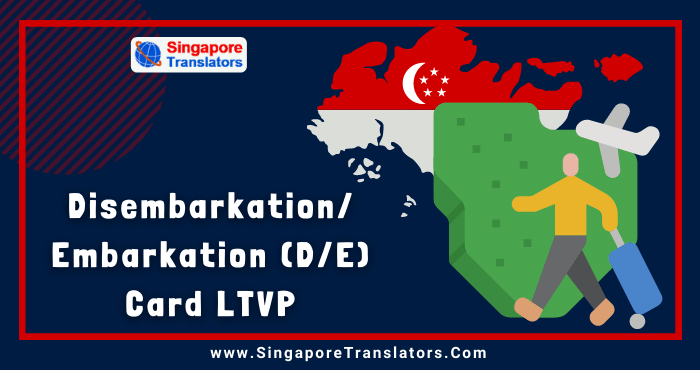One of the important documents you will be introduced to while travelling to Singapore is the Disembarkation/Embarkation Card. It is necessary for all travellers upon arrival in or departure from Singapore. In case you have been issued an LTVP, or Long-Term Visit Pass, which is the pass issued to foreigners who intend to stay in Singapore for a longer period, a proper understanding of how to fill out this card is very important.
This tutorial will make sense of the D/E Card Singapore in clear-cut terms and help you understand all that one needs to know.

Table of Contents
hide
What is the D/E Card?
D/E Card stands for Disembarkation/Embarkation (d/e) Card, and it is a document that needs to be filled out when entering or leaving Singapore. The form captures information about one’s self, which helps the ICA enforce immigration and border security. There are two parts to this card:
Disembarkation Card: Upon arrival in Singapore
Embarkation Card: Upon leaving Singapore
Who Has to Fill Out the D/E Card?
All Visitors: All of you visiting Singapore, either as a tourist or coming for work or visiting your family, have to fill up this card. It also includes people on LTVP.
LTVP holders: If you are in possession of an LTVP-a special pass granted to individuals who need to stay in Singapore for an extra period, such as family members of Singapore citizens or permanent residents are equally obliged to fill in this card when arriving in or departing from Singapore.
Get Fast & Accurate official notarization for ICA, MOM, MFA.
Why is the D/E Card Important?
The D/E Card is an important document in Singapore, where in you keep track of your working or personal particulars, especially if you’re a foreign worker or student.
Here in lies the reasons why it’s important:
Identification: It helps you identify who you are by proving it. It carries your name, photo, and other information that would show people what you are and who you are.
Work and Study: The D/E Card will prove that those working or studying in Singapore may legally be in the country. It helps your employer or school confirm that you have been granted permission to work or study in Singapore.
Access to Services: The card may be used to access certain services available in Singapore. This might include when one goes to any relevant government offices or health services.
Legal Obligation: In most instances, this card is a legal necessity for all foreigners staying or working in Singapore, indicating that you are within the set government regulations.
Record Keeping: The D/E card aids the various authorities in Singapore in being informed about persons arriving and departing their country. This information is normally crucial regarding security and immigration recordkeeping.
LTVP: Even on an LTVP while residing in Singapore, you are supposed to fill out the D/E Card. It helps confirm your status with follow-through on the requirements of your stay.
In short, the importance of a D/E Card includes its usage to prove your identity and allow you to stay in Singapore as well as enable you to use various services.
Hire a Language translator for converting your legal & Other Documents.
How to Fill Out the D/E Card
Get the Card: You will get the D/E Card from the airport or other entry and exit points like seaports. Some also make the card available online before your travel.
Personal Information: You shall provide your personal information on the card. You are obligated to give:
Full Name: Your complete name according to your passport.
Passport Number: The number from your passport.
Date of Birth: *Your date of birth.
Nationality: *Your country of citizenship.
Purpose of Visit: This shall be your purpose for entry to or leaving Singapore. For LTVP holders, you could state that this is to visit family or continue living in Singapore.
Flight or Travel Details:
Flight Number/ Vessel Name: Fill in the flight number or vessel name on which you will travel.
Date of Arrival/Departure: Fill in your date of arrival or departure from Singapore.
Entry and Exit Particulars
Entry Particulars: In case of arrival in Singapore, fill in the flight or ship details for arrival into Singapore. For this, please note that you have to indicate your flight number or the name of the ship.
Exit Particulars: State the exit flight or ship details in case you are leaving the country.
Address in Singapore: Fill in the address where you will be staying in Singapore. For LTVP holders, this is normally your sponsor’s address or your residence.
Sign and Date: Once all the information has been filled in, sign the card and date it. This will attest that to the best of your knowledge, the information that you have entered is true.
No 1 Online Translation Services for Document & Legal Translations in Singapore.
Where to Get the D/E Card
Normally, the D/E Card can be gotten from:
Airports: The D/E card is usually available at the Singapore Changi Airport or any other entry/exit points.
Online: Countries provide an electronic version of the D/E card that you can fill out prior to your trip.
Where to Submit the D/E Card
Upon Arrival in Singapore: Upon your arrival into Singapore through the airport or seaport, you are required to present your completed D/E Card to the immigration officer. Your card and passport will be sighted.
Upon Departure from Singapore: When you leave Singapore, you will be asked to produce your D/E Card at an immigration checkpoint.
Special Considerations for LTVP Holders
LTVP Information:
Here are a few of the things you should keep in mind if travelling to or from Singapore on an LTVP:
Carry your LTVP with you at all times, along with your D/E Card. If you leave or arrive in Singapore, the immigration officer may ask for the two documents. LTVP serves as proof that the holder can stay in Singapore for a longer period than usual; this is normally due to being a family member of a Singapore citizen or permanent resident.
Verification: The immigration officers will use your LTVP to verify your right to stay in Singapore. They may check whether your LTVP is valid and if it matches your D/E Card information. Failure to have your LTVP with you or problems with the pass itself, can also delay entry or exit.
Compliance with Conditions:
As a holder of the LTVP, there are some rules and conditions to be followed so that your pass can remain valid. What you are required to do is:
Comply with Conditions: Your LTVP may have certain conditions imposed on its issuance, such as not being able to work or reporting changes to personal particulars. Understand these conditions and ensure you comply. For example, if you are required to report a change in address, do so within the required timeframe.
Report Changes: In the case of a change in your address or other major variation in your situation, you need to report it to the proper authorities. In Singapore, this would normally be done by updating your particular information to the ICA or the proper agencies concerned. Lack of reporting these changes could lead to problems regarding your LTVP and, therefore, your stay in Singapore.
Renewals and Extensions:
Your LTVP is temporary and has an expiry date. Here’s what you need to know about the renewal or extension of your pass:
Expiring Pass: You must make a note of when your LTVP will be expiring. It is preferable that you initiate the process for its renewal before the pass actually expires to avoid gaps in your legal status in Singapore.
Apply for Renewal: You must apply for the renewal of the LTVP, typically close to the date of expiry. All this may be done through submitting extra documents and is usually accompanied by a review process. Make sure this process is started early enough to avoid last-minute challenges.
Additional Documentation: In the process of renewal, you may be asked for additional documents or information. This may range from a continued relationship with the sponsor, and financial documents, to any other supporting document. Always be ready with such documents and submit them when need be.
With these special considerations, LTVP holders can ensure their stay in Singapore will be smooth and in total compliance with all the regulations set forth.
Get Fast & Accurate official notarization for ICA, MOM, MFA.
Common Issues and Tips
Incomplete Details: Fill out all the fields of the D/E Card. Ensure the information given is accurate in order to not a delay on immigration problems.
Lost/Damaged Card: In the event that a D/E Card is lost or cards get damaged, in some situations, one may have to fill out another. Get in touch with the immigration authorities.
Change your information if, before you turn in your D/E Card, something changes about your journey or about yourself.
Keep Copies: It is a good idea to keep a copy of the filled-out D/E Card for your records. This can be useful if you need to refer to it at some later time.
What Happens After Submission?
When you submit the D/E Card:
Entry – If one is entering Singapore, then the immigration officer will check your card with your passport and other necessary documents.
Exit- If one is leaving Singapore, he will get his card processed and his or her departure shall be noted upon.
Conclusion
The D/E Card is a very simple yet significant form that has to be filled out by each entrant and exiting person in Singapore, especially those under an LTVP. By accurately filling it out and submitting it, you will have helped ensure that your entry or exit from Singapore goes smoothly. Keep your information updated at all times and observe the requirements of Singapore’s immigration procedures to avoid any complications when travelling.
Hire our certified language translation service in Singapore
We hope that the above-mentioned information about the card of disembarkation/embarkation helped you understand what role it plays and how vital it is in your immigration journey to Singapore.
If you are in search of a reliable immigration document translation agency, then without thinking much you can rely on Singapore translators. They have a team of certified translators that will provide you with the smooth delivery of official documents translation in Singapore.
